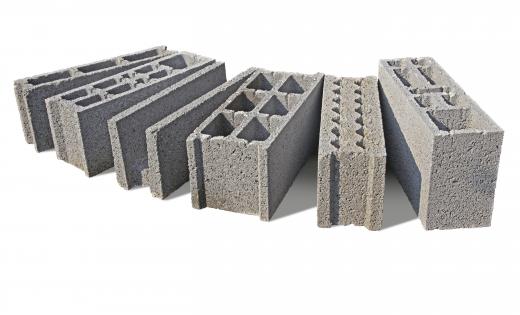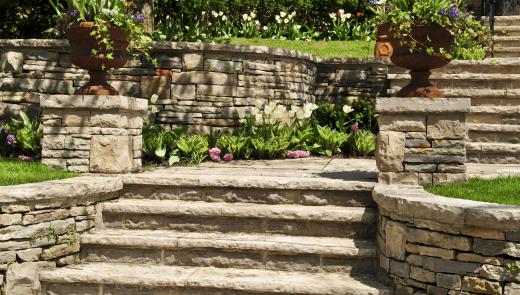What is a Gravity Wall?
A gravity wall is a type of retaining wall. It gets its name because it uses the force of gravity to remain upright. Like other retaining walls, gravity walls are used to separate or terrace different levels of land. They are built against hillsides and designed to resist the lateral force of the earth behind them. Used in landscape design, gravity walls can transform uneven terrain into usable, flat surfaces.
In its simplest form, a gravity wall consists of stacked stones or blocks of concrete. Requiring no additional materials or technology, these walls have been around for thousands of years and can be found all around the world. Historically, gravity walls have been used to separate different levels of earth as well as to keep earth and water separate. A wall built from stacked stones needs to be repaired or rebuilt frequently, because the force of the earth or water behind it will eventually knock it over.

Modern gravity walls are usually built from hollow, interlocking materials, such as cinder blocks, which add frictional resistance to the force of the wall’s weight. Hollow building materials are advantageous because they are easy to transport and light enough to be lifted and maneuvered into position by hand. After the materials are in place, they can be filled with small stones, which give the wall greater weight and resistance; a gravity wall must be built heavy in order to hold back the earth behind it.

Thicker at the base than at the top, a gravity wall is often built slanting back against the earth it is retaining. Aesthetically, this incline, called battering, makes the wall appear strong, and seeing a backward curve is a sign that the wall is functioning properly. Over time, the force of the hillside will cause the wall to bulge outward. A gravity wall that appears to be leaning outward might be unstable and ready to be rebuilt.
Depending on the type of soil that needs to be retained, a gravity wall works best when it is no taller than 3 or 4 feet (1 or 1.3 m) high. Generally, the wall must be constructed to be half as thick at the base as it is tall, which can make building tall gravity walls impractical. Anchoring the wall to the hillside is recommended for gravity walls more than 4 feet (1.3 m) high. This anchoring provides extra stability and increases the life of the wall.
AS FEATURED ON:
AS FEATURED ON:












Discussion Comments
@amysamp - I am just an amateur do-it-yourself'er (DIY'er) but while looking up trying to build other items, I ran into videos and discussions on how to build gravity walls or retaining walls.
The ones you saw sound gorgeous. I had mostly seen retaining walls that had not carried such a beauty with it, since they are very functional structures.
From what I could tell from the videos I watched, building a gravity wall was over my skill limit but I would check the videos out. Even if they are not a DIY project for you, if you hire someone else you will have a better idea of how much the materials and labor will be.
I just saw a few walls put into a mansion's landscaping and they were beautiful, and now I know they were functional too.
They had the gravity walls in such a way it gave depth to each layer and each layer had different vibrant flowers which would have for a backdrop the next gravity wall made of stone. It was gorgeous.
Where can one look to get a amount of small gravity walls placed in their yard to help create this look while also helping their hilly yard to stay in place?
Post your comments